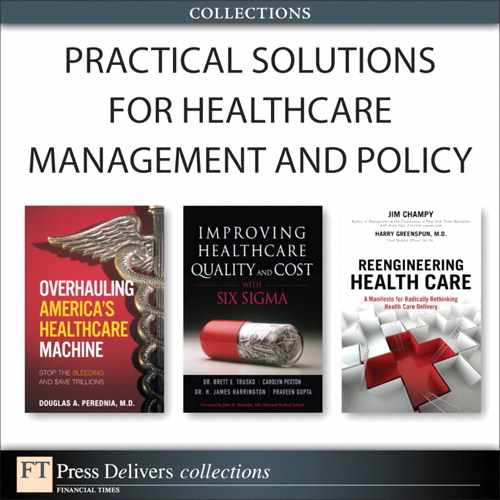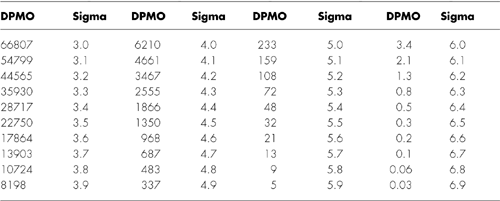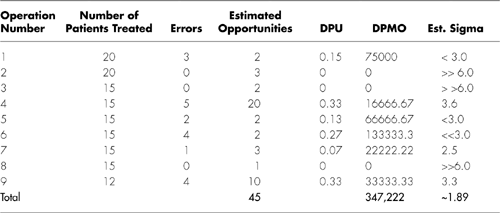Chapter 5
Six Sigma Methodology
Sections
Six Sigma Defined
Six Sigma Readiness
Six Sigma Methodology
Six Sigma Measurements
Six Sigma and Other Quality Systems
Making Six Sigma Work
Six Sigma was developed in an environment of extreme competition in new industries, poor economic conditions, and where survival was at stake. Seeds of Six Sigma were sowed in 1981 by the leadership of Motorola when they decided to do some thing different in order to continue to stay in business profitably. Continuing on the success of process improvement efforts in 1986, the leadership team decided to accelerate improvement through employee participation. The rate of improvement was changed from ten times in five years to ten times improvement in two years. Concepts of Six Sigma evolved based on the incremental performance of then improvement techniques such as Statistical Process Control (SPC), Pre-Control, Variability Reduction Methods, and Design of Experiments. It was observed that each function was disjointedly improving its performance without assessing impact on other departments. Besides, the personal computer age was at its beginning and about to explode. Complexity of products and services was increasing, even though the physical size was decreasing. For example, a computer chip could have millions of devices and hundreds of process steps. The more complex an operation or product becomes, there are more opportunities for things to go wrong. On top of the intrinsic variables, competition was intensely growing from domestic as well as international players, which led Motorola to look ahead to the year 2000 in 1985 for strategic reasons. Benchmarking was performed, and best practices were studied in products as well as services. Competitive products in telecommunication and consumer electronics were analyzed, and manufacturing technology was examined to establish the direction.
Bill Smith, the inventor of Six Sigma, recognized that something different had to be done. Different intent, methodology, and measurements had to be devised. Bill created the Six Sigma model that was built on experiences of various corporate initiatives, along with his visionary approach to address the expectations for Motorola products in 2000. This visioning led to the customer expectation of virtual perfection in everything, and thus quantified to be at 3.4 parts per million. The absence of such a model of perfection will lead to wrongly prescribed, or filled prescriptions, erroneous surgeries, and eventually deaths in the healthcare industry, just like defective products or services delivered to customers. The extent of malpractice insurance and risks highlights the level of performance that needs a step up in the level of performance to its customers, and thus reduce risks associated with its practices.
Six Sigma Defined
Six Sigma initially was developed as an improved methodology of process improvement to meet customer expectations and maintain Motorola’s leadership position in the marketplace. The Six Sigma methodology consists of the following six steps:
1. Define your products or services.
2. Know your customers and their critical needs.
3. Identify your critical needs to meet customers’ critical needs well.
4. Establish a process of doing your work consistently.
5. Error-proof your process and eliminate waste.
6. Measure and analyze your performance. If not perfect, improve your process.
These six steps are supported by various tools already known in the Total Quality Management (TQM) environment, and strong and demanding leadership throughout and with measurements. Most importantly, employee participation was demanded and success rewarded. During the first five years of Six Sigma implementation, even suppliers were required to participate in the process, and customers were encouraged to benefit from the Motorola experience. The four courses that propagated the Six Sigma philosophy throughout the Motorola supply chain were the following:
• Understanding Six Sigma. Basic concepts of Six Sigma, measurement, process mapping, and implementing six steps to Six Sigma.
• Design for Manufacturability. Designing products, Motorola being a product company that could be manufactured virtually perfectly.
• Cycle Time Reduction. Streamlining operations through removal of nonvalue activities and waste of resources, including of time. The five elements of cycle time of a process are setup time, wait time, move time, queue time, and runtime. The runtime happens to be the only value added time, and is estimated to be about 5 percent.
• SPC (statistical process control) Overview. Overview of various statistical concepts and tools, integrated into the four-phase methodology: Visualize, Analyze, Improve, Optimize.
Success of initial implementation of Six Sigma at several companies led experts to package Six Sigma into a robust approach that included the DMAIC methodology, application of methodology through projects, and standardized training programs such as Black Belt or Green Belt, and roles as Champion and Sponsors.
GE, led by its CEO Jack Welch, innovated Six Sigma through rigorous implementation at all levels, and enabled GE to grow profitably for several years. GE leadership credited its success explicitly to Six Sigma, besides other strategic initiatives. After some time, GE executives took the Six Sigma discipline to their new employers and replicated success. This continual success of Six Sigma transformed Six Sigma from a simple process improvement methodology to a business strategy at the highest level, even to the level of corporate values.
One of the distinct and visible aspects of a successful Six Sigma campaign has been the visibility of the chief executive. The leader must be the Six Sigma crusader; the crusade cannot be delegated to the vice president or a subordinate. Certainly, a Six Sigma campaign must not become a quality campaign; otherwise, it would be treated as a program for compliance certification, bureaucracy, or paperwork. Six Sigma must be implemented as a business strategy to improve profits and achieve growth with the help of improved capacity and employee-driven innovation.
Thus, one can define Six Sigma as a futuristic strategy to immediately improve corporate profitability through waste reduction, achieve growth through sustained profits, and create a culture of continually achieving best-in-class performance through process reengineering.
Six Sigma can be thought of as having the following five elements:
1. Intent. The intent of Six Sigma is to achieve a lot of improvement very fast (for example, rapid improvement to achieve best-in-class status).
2. Strategy. Six Sigma can be applied in a limited sense at project level, or with a strategic intent to implement throughout a corporation.
3. Methodology. DMAIC is the methodology to achieve results. The discipline to follow the methodology is bound to produce results. The most important step is the Define phase of DMAIC.
4. Tools. Numerous tools have been incorporated in the Six Sigma methodology. The unique tools that have been found to be useful are Kano’s model to capture customer critical requirements, SIPOC (Suppliers, Inputs, Process, Outputs, Customers), statistical software for analysis, multi-vary analysis for identifying predominant family of variation or inconsistencies, planned experimentation, and methods to sustain gains.
5. Measurements. The three commonly used measurements are DPU (defects/errors per unit), DPMO (defects per million opportunities), and Sigma level. The DPU is a unit or the output level measurement, DPMO is the process level measurement, and Sigma is a business-level measurement. Sigma provides a common theme for the organization, and requires a lot of improvement to show a positive change.
Six Sigma Readiness
One of the reasons for false starts of the Six Sigma initiative is not identifying opportunities for improvement in the bottom line, and blindly committing to the Six Sigma initiative. As a result, the initiative gets launched with fanfare; however, the fun and commitment dwindles over time due to lack of value creation. Thus, for management to commit to a Six Sigma initiative, the questions that must be answered are what can the Six Sigma initiative do for the company, in the short term and in the long term? How much would it cost? Table 5.1 provides some answers in order for a company to realize benefits of Six Sigma methodology during the first year.
Table 5.1 Estimated Costs of the Six Sigma Initiative

Gupta, www.CircuitsAssembly.com, 2002
Once the implementation of the Six Sigma initiative becomes an economically viable strategy, management must consider giving it the highest priority. Any competing initiative, conflicting priority, or strategic initiative in progress must be clearly identified. Besides the economic viability, the other success factors must be addressed. A list of critical success factors is as follows:
1. Leadership needs to have an unwavering commitment to Six Sigma.
2. Common language is used for setting up common goals..
3. Aggressive improvement goals will promote employee engagement.
4. Innovation is the key to achieving dramatic improvement.
5. Process thinking allows decisions to be made based on knowledge and data, instead of just the data.
6. The company needs to maintain continued interest in the Six Sigma initiative.
7. The company needs the right metrics for identifying opportunities for new projects and dramatic results.
8. Rapid improvement must become a way of life.
9. Reward for creating value is essential for continually engaging employees in the Six Sigma initiative.
For the executive leadership to be engaged in the Six Sigma initiative, they must develop a proper understanding of the principles behind Six Sigma. The understanding of intent of the methodology, key tools associated with various phases of DMAIC, and any organizational bottlenecks are critical requirements for launching a successful Six Sigma initiative. The leadership involvement in the Six Sigma must be documented for clear understanding and consistent implementation. They must see the big picture of the Six Sigma initiative which goes through various functions of the organization. The table in Table 5.2 identifies key tools recommended for executives. Having understood the intent of Six Sigma, and key executive tools, the leadership is able to appreciate the effort required to achieve the desired business objectives.
Table 5.2. Key Executive Tools
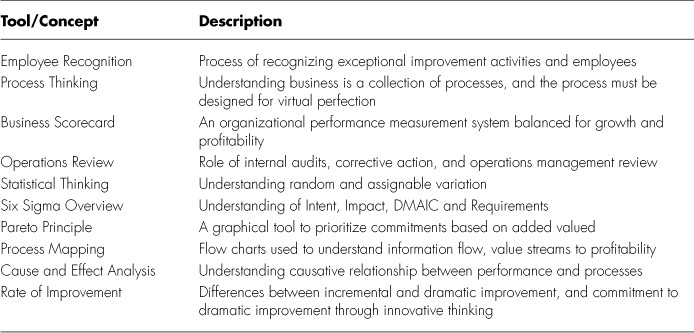
Printed with permission: Gupta, Six Sigma Performance Handbook, 2004
Six Sigma Methodology
The Six Sigma methodology has been known as DMAIC representing the Define, Measure, Analyze, Improve, and Control phases. The methodology is applied to the projects selected from multiple projects based on the project prioritization index (PPI), which is calculated as follows:
PPI = (Benefits/cost) × (Probability of success/Time to complete the project in years)
Because the project duration for a Six Sigma project is expected to be four to six months, and the probability of success must give the project a chance to succeed, which can be estimated to be at .7, then the PPI becomes as follows:
PPI
= (Benefits/Cost) × (.7/.5)
= 1.4 × (Benefits/Cost)
To benefit from the project beyond any chance, the recommended PPI is 3 x (Benefits/Cost). If the project is critical to business, lower PPI numbers may be accepted with the management’s approval.
Once the project is selected, the team representing various functions is formed to work on it. The team receives the Six Sigma training at the Green Belt level while working on the selected project. During the Define phase, the expected outcomes are as follows:
1. A clear definition of the project and its scope
2. A determination of the customer’s critical requirements
3. Benefits of the project completion, or the value proposition
4. A common understanding of the process
5. Identification of various elements of the process
6. Plan to complete the project
In the Measure phase, the process performance and elements are reviewed for establishing a causative relationship. Team members review all the available data, and establish a performance baseline in terms of error rate, or its capability with respect to requirements. In establishing the baseline, a commercially available statistical software program can be used for developing the basic statistics. The basic statistics consists of at least the following information:
• Central Tendency measures such as mean for variable data or median for attribute data
• Variation or inconsistency measures, such as range or standard deviation
• Defective PPM based on distribution, or defect counts
Besides establishing the baseline, one must also analyze trends in the performance related to the critical process elements that would include inputs, process steps, or any other opportunity for making mistakes. In the Define phase, we identified variables relating to the process elements. We recognize that now the problem-solving task is to eliminate trivial variables from further analysis.
In the Analyze phase, team performs the cause and effect analysis using either the Ishikawa diagram or the Fishbone diagram. The objective is to analyze the Y = f(Xi) relationship, and reduce the number of variables such that either team is able to identify necessary actions to improve the process, or prepare for planned experimentation in the Improve phase. The Multivari analysis is a unique tool that is simple to use. This tool apportions the process variation in three families of variation and reduces the scope of the problem. The three families of variation are called Positional, Cyclical, and Temporal. The Positional variation relates to the location of errors in the process. The location could be influenced by the process such as same step, certain individual, or certain tool or equipment. The locational variation is repeatable and typically corrected through process or product design. The Cyclical variation is related to a process cycle, which is normally affected by the process set up affecting the cycle. The Temporal variation relates to the trends in the process output which is affected by maintenance or degradation of certain process elements. Thus, the family of variation with maximum inconsistence is selected to work on, and variables associated with the other two families of variation, are temporarily set aside.
Besides the Multivari analysis, other tools in the Analyze phase include FMEA (Failure Modes and Effect Analysis) and testing of hypothesis, which are used for anticipating potential problems with a process and statistical evaluation of various process conditions, respectively.
The Improve Phase is used to develop alternate solutions to achieve the desired process outcomes. In an unstructured or non-Six Sigma method of problem-solving, one jumps into the Improve phase directly without properly defining the problem, establishing the baseline, or an appropriate root cause analysis. Once alternate solutions are developed, the best solution is selected based on statistical evaluation, and the process further optimized. The intent of the Improve phase is to develop a breakthrough solution that would lead to significant improvement in the process performance. Again, statistical software is used for evaluation and validation of the proposed solutions.
The Control Phase is used to sustain the improvement using statistical process control techniques such as control charts, or monitoring the process using trend charts. Besides statistical methods, some of the important activities in the Control phase may also include modification in the work procedures, training, communication, and management reviews.
Table 5.3 lists various tools associated with various phases of the DMAIC methodology. Some of these tools are discussed in the next two chapters.
Table 5.3. Key Simple Six Sigma Tools
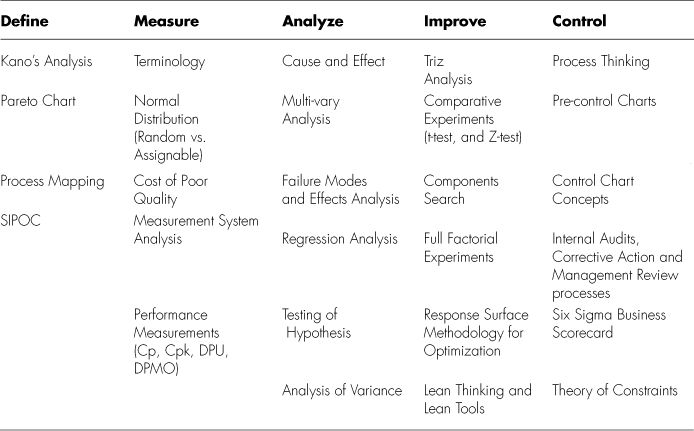
Printed with permission: Gupta, Six Sigma Performance Handbook, 2004
Six Sigma Measurements
The Six Sigma methodology incorporates a simple but powerful set of measurements, such as DPU, DPMO, Sigma level, Cp, and Cpk. The DPU stands for defects per unit, which is a measure of product performance with respect to customer expectations. In healthcare organizations, DPU may be labeled as errors per unit (EPU), where the unit could be a patient visit, a surgery, clinical event, or a process cycle. The DPU is a measure of internal performance of the product before delivering it to the customer. Once we know the DPU level, we can question unacceptable levels of DPU and perform root cause analysis. Besides, if the DPU of a complex operation is compared with that of a simple operation, the comparison could be misleading. Thus, the DPMO (Defects Per Million Opportunities) measurement has been created where the DPU is normalized for the complexity of an operation. For example, the complexity of a patient’s visit for a normal checkup and the complexity of a surgical operation are quite different, thus a different error rate would be expected. Thus to improve the error rate, one must simplify operations and reduce opportunities for errors. The formula for calculating DPMO is as follows:
DPMO = (DPU * 1000,000) / Average number of opportunities in a unit
Once the DPMO is calculated, a sigma level can be determined using Table 5.4, or equivalent methods.
Table 5.4. DPMO to Six Sigma Conversion Table
The Sigma level can be used to compare departmental level performance and accelerate improvement in the Sigma level. As one can see that to change Sigma level from 3 to 4 about ten times, from 4 to 5 about 30 times, and from 5 to 6 about 70 times, improvement is needed. Overall, to improve sigma from 3 to 6, about 20,000 times improvement is needed. We have never heard of such a high requirement for improvement. In the absence of such a measure, we tend to establish incremental goals for improvement and achieve invisible improvement in our operations.
Here’s an example: If a surgery for a hernia is being performed, there are several steps, which are listed as follows:
1. Initial visit. Visit with the doctor for hernia pain or discomfort, and fill out insurance paperwork.
2. Follow-up visit. Schedule the surgery, determine the method of surgery (laser or mesh), sign a liability release, and inform the patient of surgical risks.
3. Pre-surgery preparation. Give anesthesia and prepare the patient for surgery.
4. Surgery. Prepare for surgery (the operation table, tools, nurses, doctors) and perform the actual surgery (mark, cut, mesh, close).
5. Post surgery. Monitor recovery and administer painkillers.
6. Release. Provide instructions for home recovery, and make a follow-up call.
7. Follow-up visit. Verify surgery outcome, patient’s satisfaction, and close paperwork.
8. Receive payment from patient. Collect the co-payment from the patient.
9. File claims. Submit necessary paperwork to insurance companies or Medicaid for payments.
One could see that a hernia operation includes nine processes, and each operation has opportunities for making mistakes (see Table 5.5).
Table 5.5. Hernia Operation Analysis for One Month
From the data analysis, one can see that operation number four, which is "surgery," operates at the best Sigma level among all processes, even with the highest number of errors. This may confuse some of us, and lead us to believe that Six Sigma is a counterproductive methodology. We can conclude the following:
• The surgery operation is the most critical operation.
• We must focus on making it at least Six Sigma level, or even higher. This may even impact our malpractice insurance rates because of lower risks.
• We do have some operations that perform almost perfectly, thus focusing our attention on areas that are critical and need improvement. We should learn from people working in those areas how they ensure perfection over a period of time.
• We should not pay too much attention to the absolute value of the measurement, because it may depend upon the measurement methods. Instead, we must strive to improve critical processes very fast to benefit from saving resources in those areas.
Such analysis of the data for various departments will assist us in identifying opportunities for improvement and defining projects to implement Six Sigma methodology.
If one wants to determine overall sigma level for the hernia operation, one adds all DPUs and the opportunities, and determines the DPMO and Sigma level. In this case, the overall Sigma level is 1.89, and DPMO is 347,222. This implies that overall the hernia operation has a long way to go to become virtually perfect, and if 100 surgeries are performed in a month, about 3 would be unacceptable. The risk of malpractice in the three cases may wipe out profits realized from the other 97 surgeries. That’s how one must look at the performance of healthcare services, rather than just accepting that there is a risk of 3 percent failure and have patient accept the risk helplessly.
Six Sigma and Other Quality Systems
Healthcare organizations, especially hospitals, already have too many regulatory and compliance requirements. There are accreditation programs for various departments, disease-specific certifications, staffing standards, professional licenses, and best practices. However, there is a need for business-like management systems and performance standards. Customers have not been able to drive performance of the providers; instead, providers have been controlling the patients’ expectations. Currently, patients are at the mercy of providers instead of driving improvement in the providers’ performance. Pharmaceutical manufacturers, insurance companies, and healthcare service providers have been working together to provide more services; however, they are less concerned about the quality of services. As a result, the lack of quality feeds into the fear of malpractice and an increase in insurance premium for physicians.
However, some hospitals have already taken the leadership position of implementing quality management systems, initiating continual improvement programs, and committing to Six Sigma initiatives. Six Sigma works well with both management systems and certification requirements. A license authorizes individuals, certification qualifies specific treatments, and accreditation recognizes facilities. Thus, the management system will integrate various elements of the healthcare organizations, and Six Sigma will accelerate improvement in the quality and cost of the healthcare. Today, the cost of healthcare is more than many businesses’ profitability, thus hurting viability of employee benefits and retention of good employees. Therefore, the healthcare providers and support organizations and professionals must commit to improving performance, responsiveness, and cost. Otherwise, more self-insurance, deregulated healthcare services, alternative medicines, global providers, tele-healthcare, and off-shoring of healthcare services will become a common practice, changing the current healthcare system dramatically.
Making Six Sigma Work
So, why was Six Sigma developed? Six Sigma was developed to become best in class by achieving virtual perfection in everything. It was simply a methodology that was rigorously implemented and passionately championed. It produced results and savings of billions of dollars. Most successful champions have been the CEOs. Following are basic tenets of Six Sigma:
• Common goal
• Aggressive goal-setting
• Effective learning
• Sharing savings and rewards
• No fear!
There may be a few more, but this list is quite comprehensive. A company becomes successful when one understands Six Sigma correctly, makes Six Sigma a visible goal, continually talks about it, and works hard to achieve it. The aggressive goal-setting is fundamental to Six Sigma. As we know that Six Sigma is associated with breakthrough improvement, it really means the solution must be different from simply tweaking the process. One can see that Six Sigma is not for the faint of heart. One must have vision, guts, courage, and wisdom to achieve such monumental improvement. However, one must remember that Six Sigma is applied for customer-critical aspects of products or services in order to benefit from it quickly. One must apply Six Sigma in every process, but not to everything in the process.
Effective learning of Six Sigma implies that one should learn the intent first before learning the methodology and tools. It is like getting a car for partying on the go. The intent is statistical thinking for achieving a lot of improvement. Statistical thinking is different from rigorous statistics. Actually, statistical thinking is very simple to understand, but difficult to internalize. Statistical thinking means understanding the nature of variation, cause and effect relationship, and making adjustments accordingly.
One of the subtle aspects of a successful Six Sigma journey is driving out fear. Dr. W. Edwards Deming, the quality guru, has emphasized driving out fear in bringing out the best in people. Employees are encouraged to take risks, learn from mistakes, and accomplish breakthrough results. Six Sigma was used for becoming the market leader (for example, higher sales and the highest profit in the industry through performance improvement). Focusing on sales and cost together will alleviate employee fear of failure and losing jobs. The leadership may want to focus on sales equally aggressively because implementing Six Sigma means more capacity for facilitating growth, creating a positive environment, and driving out fear.
